The ceiling in the kitchen is subjected to the greatest loads: rapid temperature changes, high humidity, more frequent cleaning due to the inevitable appearance of greasy deposits and soot. However, it should look good, because its area is large enough and plays a significant role in the perception of the interior.
- Proper ceiling decoration helps to visually increase the height and area of the kitchen, zone the space, create good lighting and the desired interior style.
What kind of ceiling do in the kitchen, so that it is both practical and beautiful? In this material we will tell about the pros and cons of 7 popular types of finishes (click on any of them if you are interested in a particular one, or just continue reading in order):
- PVC Stretch Ceilings;
- Stretch ceilings;
- Plasterboard level ceilings;
- Plastered ceilings;
- Painted ceilings;
- Wallpaper;
- Plastic ceilings.
We also supplemented the article with a large selection of photo ceilings in the interior of the kitchen and a selection of original design ideas.
What ceiling do in the kitchen? 7 main types of finishes
Option 1. Stretch ceilings made of PVC
If you have a task to make the ceiling in the kitchen quickly, neatly and inexpensively, our recommendation is a stretch ceiling made of PVC film.
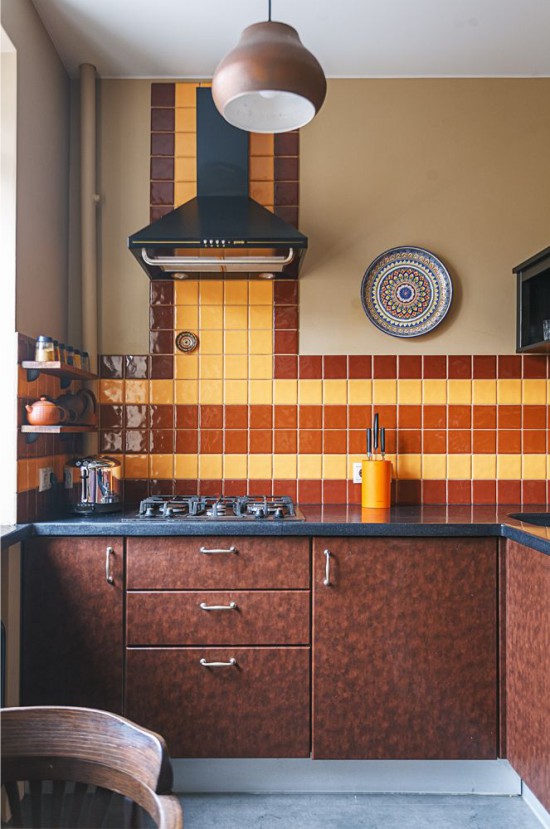
In this photo you can see a small edging around the perimeter of the stretch ceiling and see how the canvas bypasses the pipe.
Pros:
- Stretch PVC kitchen ceiling can survive a real flood - it will collect all the water (up to 100 liters per 1 sq. Meter), and after its drain will return to its original state. To drain the water, you only need to pierce the fabric with a needle in several places.
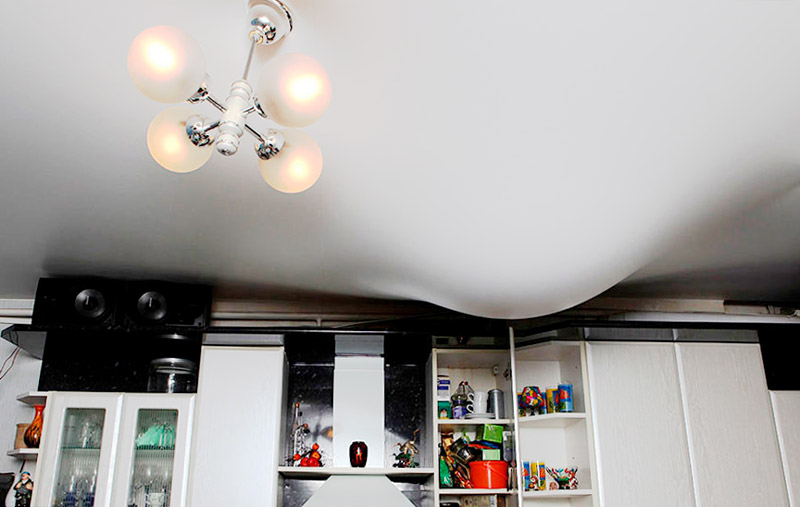
- Stretch ceiling is durable and with careful handling can last for 20 years or more.
- Stretch ceilings in the kitchen are fireproof. In the event of a fire, they will begin to curl up into a tube and melt, not emitting toxic substances, not forming smoke and not supporting the spread of fire.
- In case of minor damages, for example, cuts or holes, the tension canvas can be restored.
- When installing a stretch ceiling, you can rethink the lighting of the kitchen, for example, install spotlights and hang the chandelier over the dining table.
- Vinyl ceilings are resistant to high humidity and temperature fluctuations characteristic of the kitchen climate.
- For a stretch ceiling in the kitchen is easy to care for. He washes every 2-3 months with soap and water using a mop.
- Stretch ceiling perfectly smooth, always looks very neat.
- Variability designs stretch ceilings great. In addition, they can be combined with other types of coatings, for example, with a plasterboard level construction.
- Before installing suspended ceilings there is no need to level the base.
- Installation is fast (1-3 hours depending on the area) and with minimal pollution of the room.
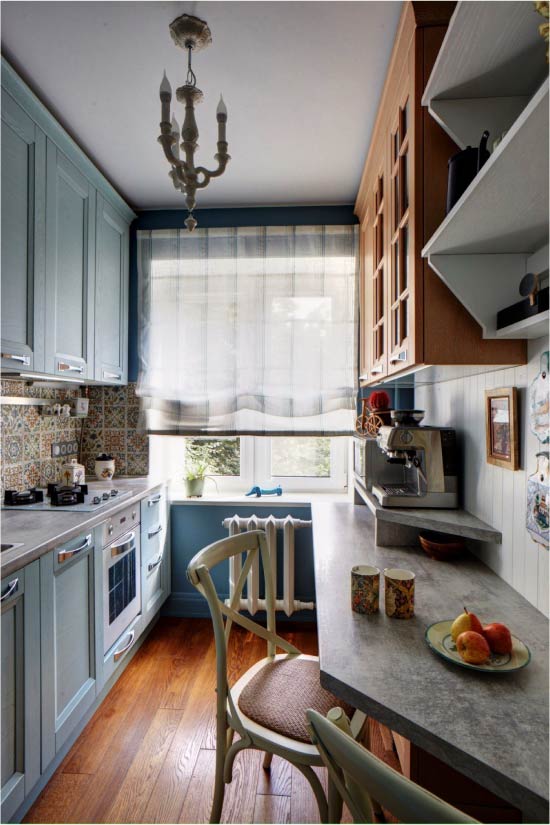
Minuses:
- The stretch vinyl can be damaged by mechanical action - so that piercing and cutting objects should be kept away from the coating, and the champagne should be opened with care.
- Because of the stretch fabric, there is a risk of not seeing the appearance of mold on the ceiling. Moreover, if the humidity level in the ceiling space increases (for example, due to flooding or condensation on the pipes), then an airtight PVC film can create favorable conditions for the development of the fungus. For this reason, it is advisable to install vinyl ceilings in the kitchen only together with built-in ventilation grilles, especially if the mold problem has already arisen in the past.
- The first time PVC film smells.
- Like any suspended structure, the stretch fabric takes precious centimeters of wall height (4-7 cm), therefore it is not very suitable for kitchens with low ceilings.
- Stretch ceilings can not be mounted independently.
- If the kitchen is too large (more than 5 meters in width), then the canvas may have a subtle seam.
- A small edging appears around the perimeter of the stretch ceiling. If desired, it can be closed with baseboards, but that's another story.
- The installation of stretch ceilings is done once and for all, so in the future to move / repair communications and lamps without complete dismantling of the canvas will not work.
- Vinyl ceilings are not compatible with all lamps and lamps. The area around the bulb may turn yellow and deform.
Tips for choosing a stretch ceiling for the kitchen:
- Stretch ceiling is matte, satin and glossy. The first option is the most versatile, suitable for both classic and modern kitchens.
If you do not know which ceiling for the kitchen to choose, then we recommend staying on a white matte stretch ceiling. Such a finish will seem to be a high-quality plastered surface, which looks much more noble than a glossy film.
- Be careful with the glossy ceiling if your kitchen is small or low. There is a common myth that glossy ceilings visually increase the space and height of walls, but in reality everything happens quite the opposite.
Glare and reflections of objects on a glossy canvas bring to the interior an extra diversity and a sense of confusion, as a result, the ceiling seems even lower than it is. In addition, often a glossy film looks like an uncomfortable plastic, which is appropriate only in ultra-modern interiors and not always.
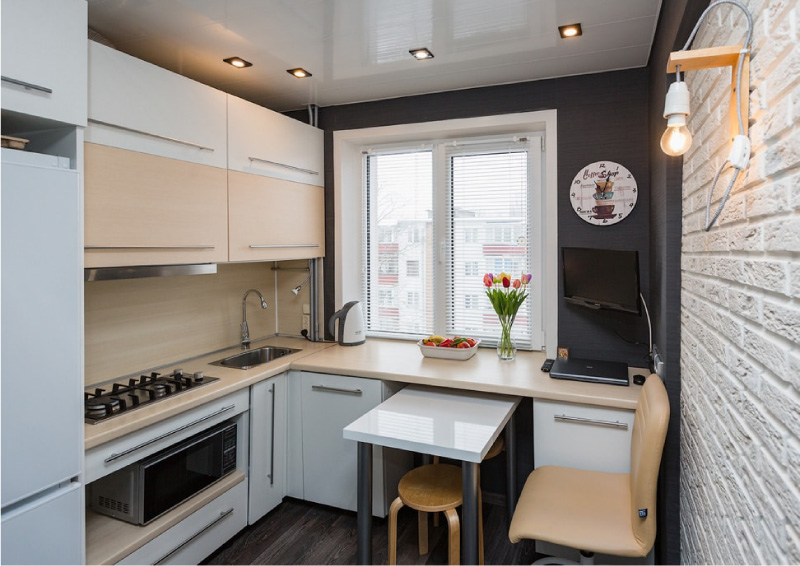
Glossy ceiling in the kitchen in Khrushchev
- Another 2 reasons against the glossy ceiling: it is more difficult to care for him, and it costs a little more than matte paintings.
- Sateen stretch ceiling is good to use in kitchens with a lack of light and restrained interior.
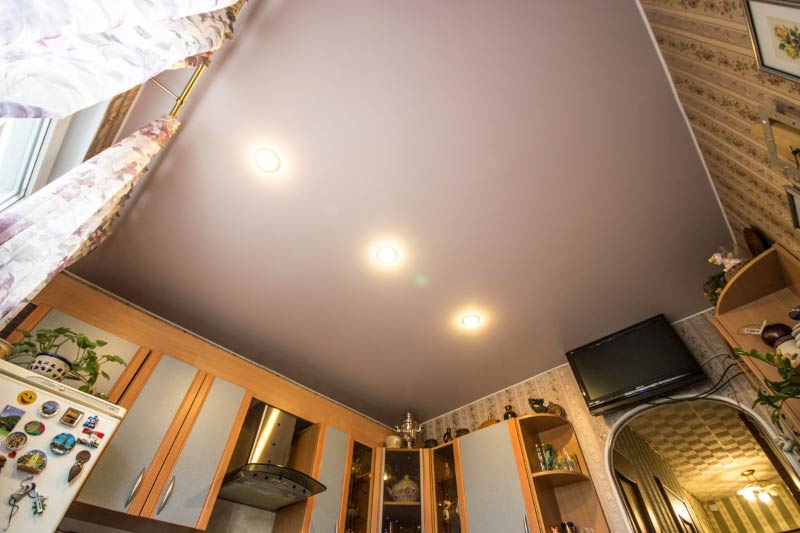
- Tension cloth with photo printing, with imitation of a metallic, wood, mother of pearl, suede, leather, marble or stone should be chosen as carefully as possible. It should be designed in the colors and style of the interior, create the illusion of a high ceiling (if it is low) and not overload the space.
For details, see the material: Stretch ceilings in the kitchen - design, care, myths and reality
Option 2. Fabric stretch ceiling
Fabric stretch ceilings are made of polyester impregnated with polyurethane. This material is quite thin, but durable and wear-resistant, so it is great for finishing the ceiling in the kitchen. Fabric cloths have almost the same advantages and disadvantages as PVC film, but there are several significant differences.
Pros:
- Due to the air permeability, fabric ceilings significantly reduce the risk of mold.
- The loss of wall height is less than when installing PVC ceilings.
- Fabric ceilings are 15 times stronger than vinyl. By strength, they can be compared with a tarpaulin. Accidentally cut, pierce or tear them is almost impossible.
- Fabrics have no seams.
- The fabric ceiling is easier to clean - it does not leave stains, stains can be easily removed locally with a damp cloth. In addition, because of the antistatic properties on the ceiling is not going to dust.
- The fabric ceiling is a textured matt white canvas, which outwardly practically does not differ from the ideally plastered surface. It is for this reason that they are often used to decorate premium class homes.
- Dense polyester does not sag, does not gather in folds and waves over time.
- Fabric ceilings better heat and soundproof the kitchen.
- Fabric ceilings can be not only white, but also colored as in the photo below. There are about 20 shades. It is also possible to print with the effect of a mural.
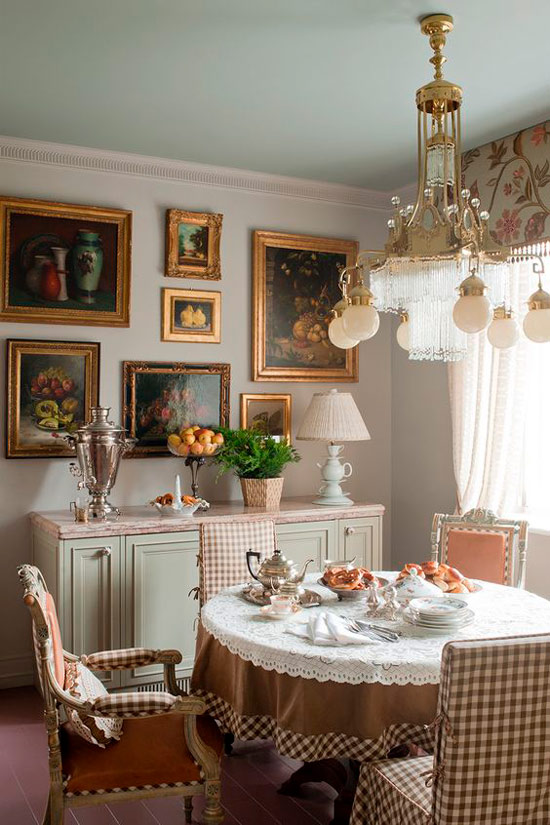
- Fabric ceilings can be painted or painted (unlike PVC ceilings).
- They are compatible with almost any lamps and lamps, even those that are very hot. The area around the bulb will not turn yellow or deform.
- Cloth fabric is installed faster and without the use of a heat gun.
Minuses:
- Cloth fabric does not hold water in the event of flooding.
- Fabric ceilings are somewhat more expensive than vinyl (+200 rubles. To the price per 1 sq. M);
- Fabric ceilings can only be matte.
Tips for choosing a fabric ceiling for the kitchen:
- In spite of the fact that the fabric ceiling "breathes", it is still worth building in additional ventilation holes. After all, the kitchen is a room with high humidity and the risk of flooding from above.
- The most popular manufacturers of fabric stretch ceilings are the brands Clipso and D-Premium (Descor).
- Want to buy waterproof fabric ceilings? Such produces only firm Cerutti.
Option 3. Gypsum ceilings
A plasterboard ceiling in the kitchen opens up a million decorating possibilities. For example, you can create a multi-level or shaped ceiling, a ceiling with zoning, or a ceiling with a rounded transition to the walls. Also, the gypsum ceiling allows you to play with the finish - it can be painted, whitewashed, covered with wallpaper.
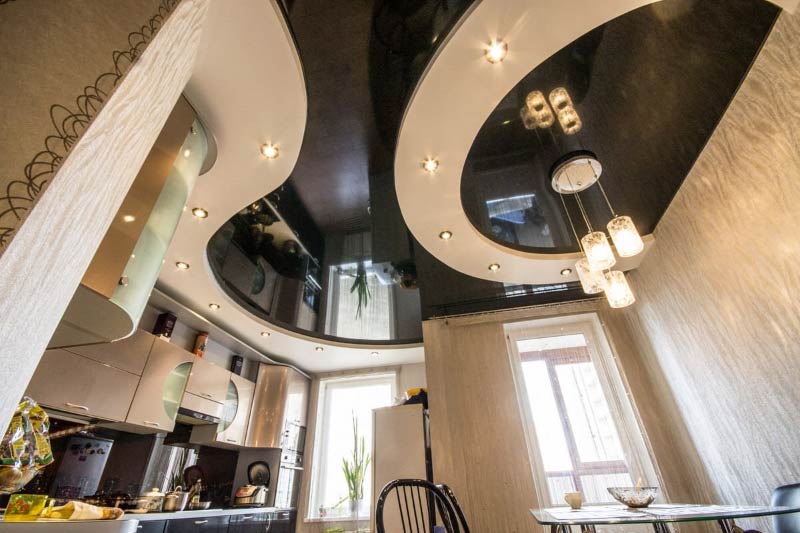
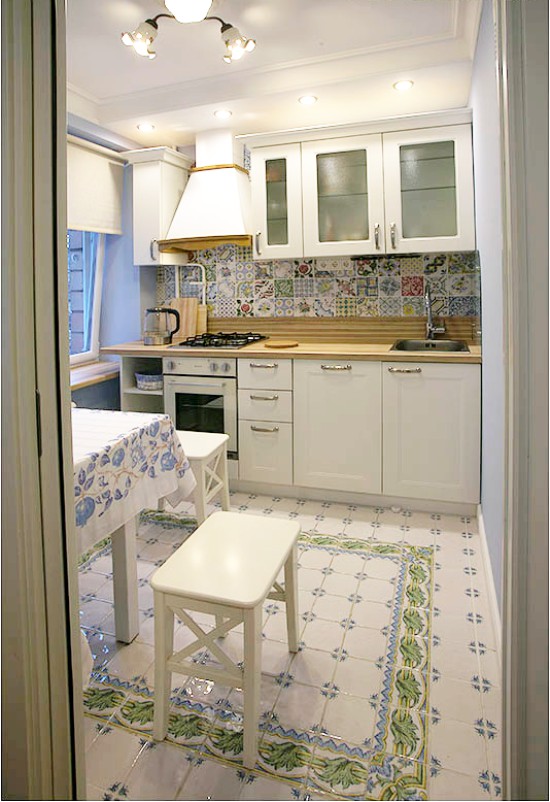
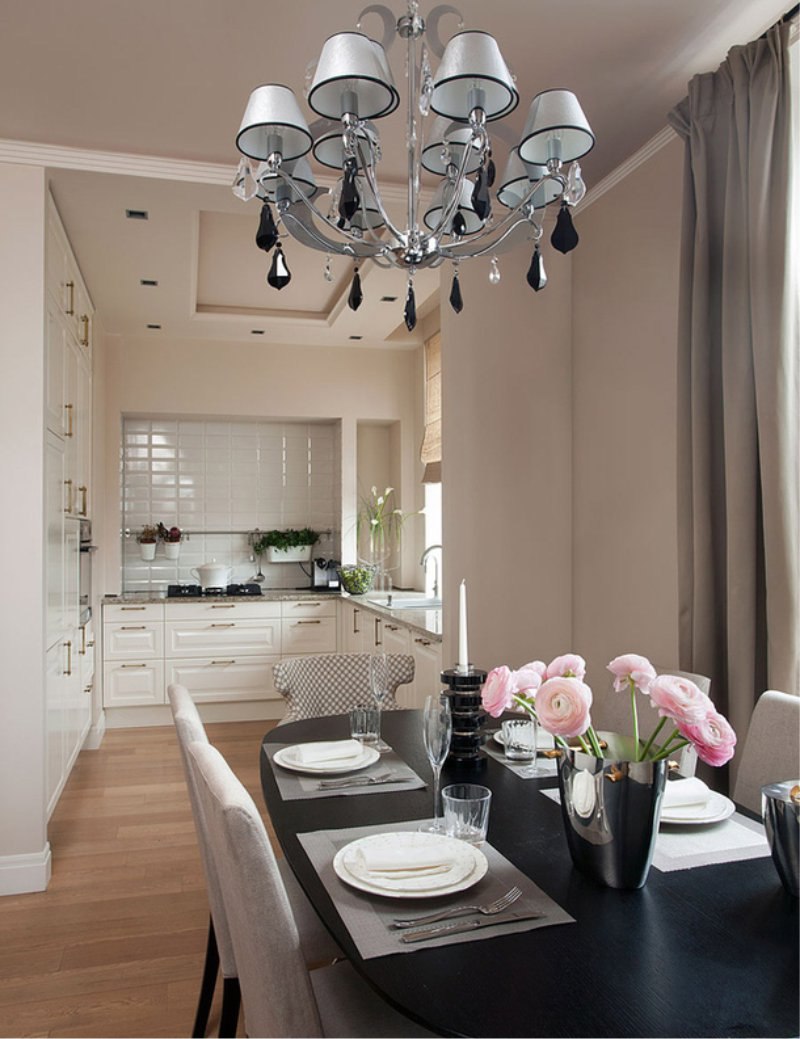
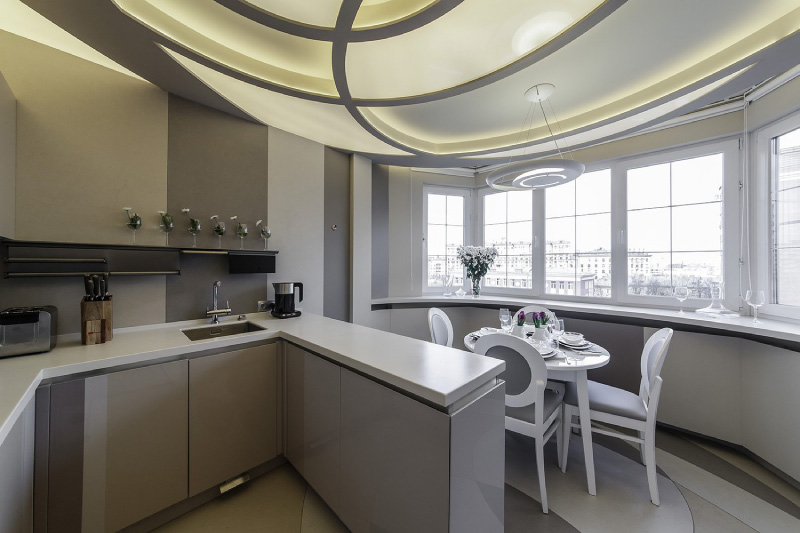
Pluses plasterboard ceilings in the kitchen:
- Allows you to completely hide the shortcomings of the ceiling and generally leave it without finishing.
- They allow you to hide engineering communications (for example, air ducts, wires and cables) and create a new lighting scenario (for example, create uniform spot lighting and move the central chandelier to the table).
- Shock resistance and other mechanical effects.
- Long service life.
- Improving heat and sound insulation.
- Variability of design, as we have already mentioned above.
- Ability to zone space level structures.
- Drywall and related materials to install the ceiling are inexpensive.
Minuses:
- Several centimeters of wall height are lost. The minimum loss will be 7 cm.
- Gypsum ceiling inevitably deforms when flooded.
- Requires additional finishing efforts.
- At constant temperature differences characteristic of the kitchen, cracks may appear between the sheets of plasterboard, which means that the decorative finish will crack. To avoid this, you need to use movable two-level CD connectors, but they significantly increase the cost of construction.
- It is impossible to sheathe the ceiling with plasterboard. All work, including calculations, must be done by professionals.
Tips for decorating kitchen plasterboard ceilings:
- To finish the ceiling in the kitchen you need to use only high-quality moisture-resistant drywall. It costs more than usual GCR for 100 rubles, has the same standard sizes, but 2 times more moisture resistance and antifungal properties.
- All seams and places of fastening sheets of the Civil Code to the profiles must be treated with water-repellent plaster. This point is worth checking at the stage of finishing the structure.
Here are some more photos of plasterboard ceilings in the interior of the kitchen.
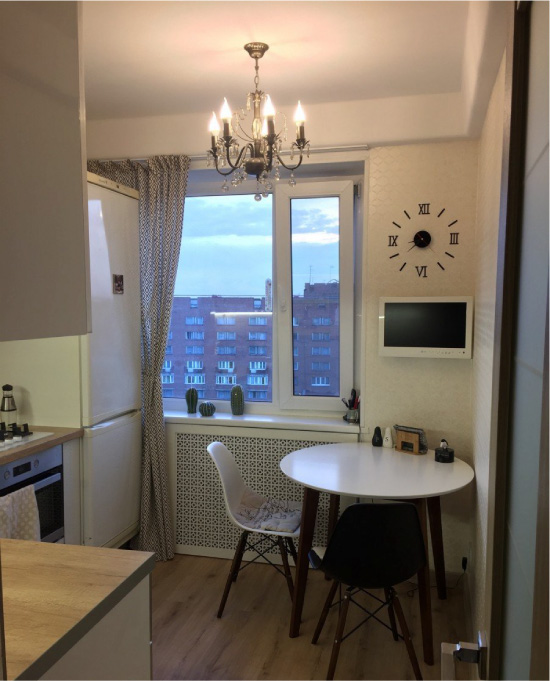
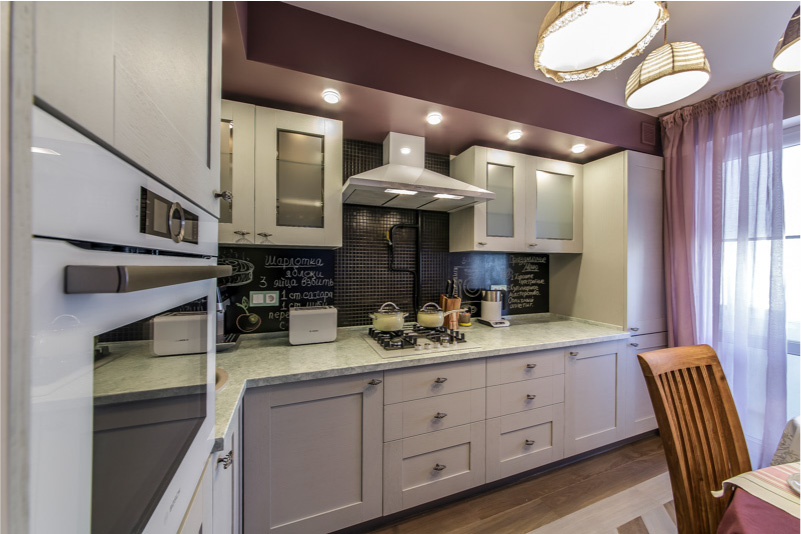
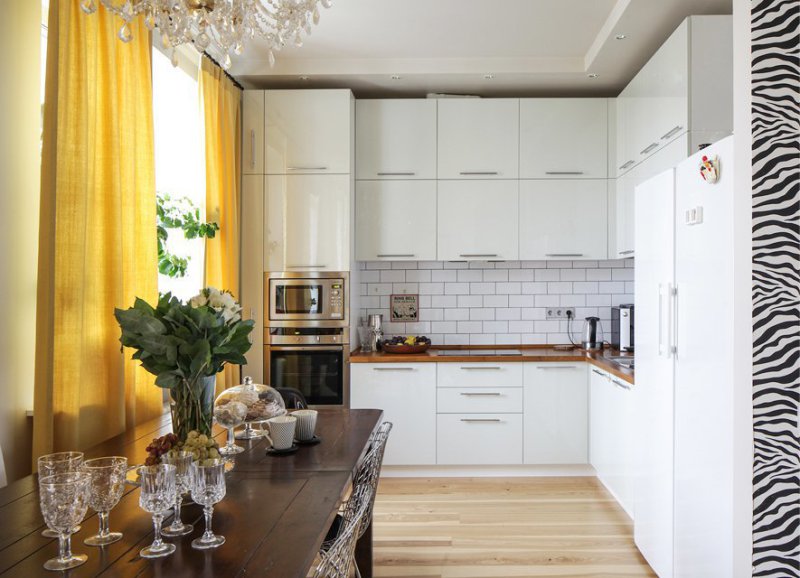
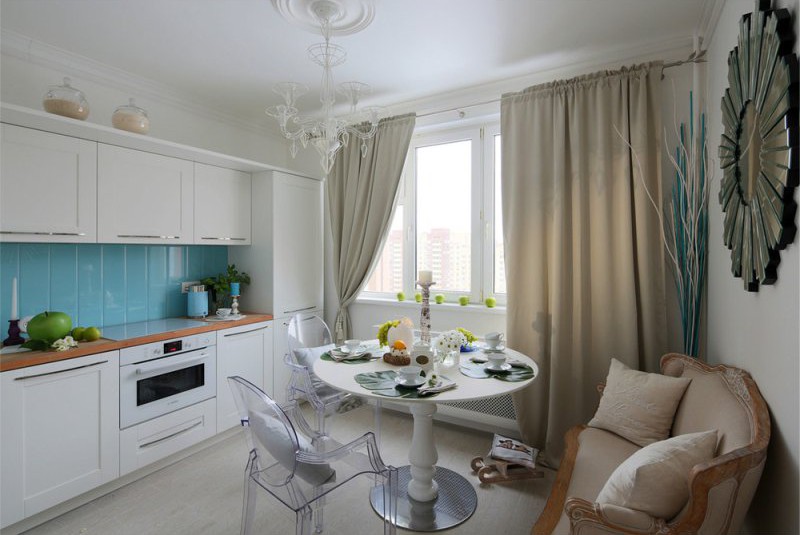
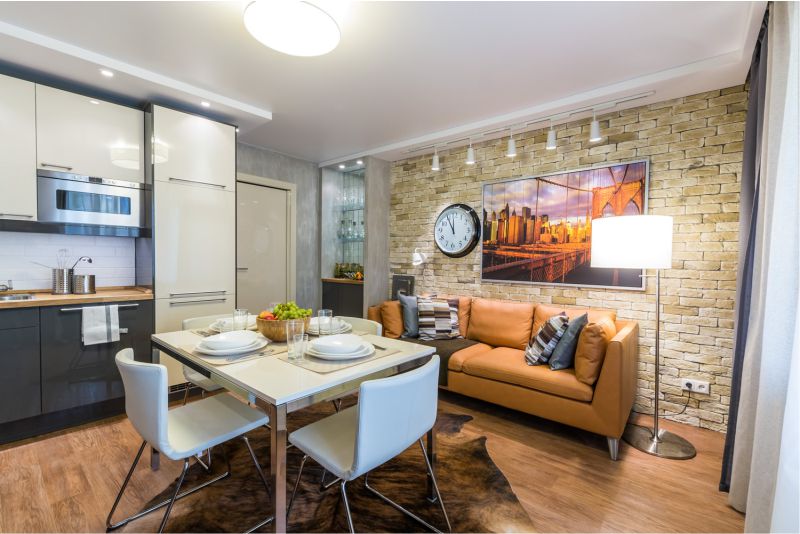
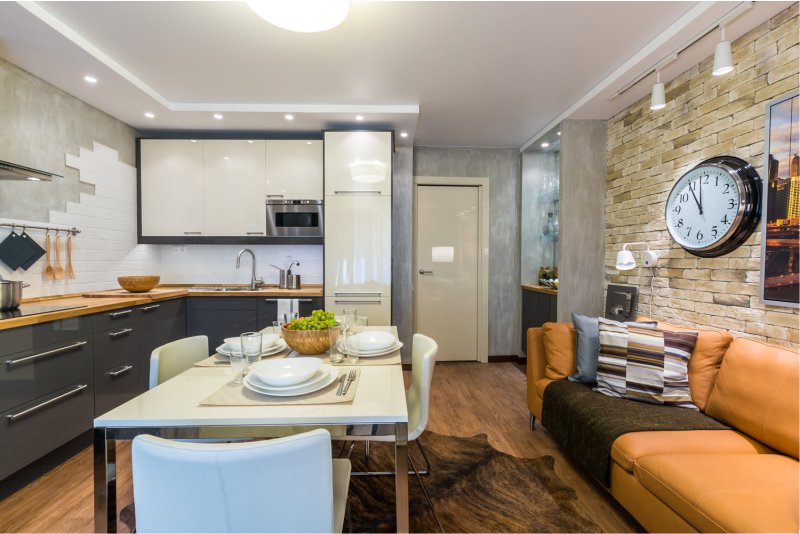
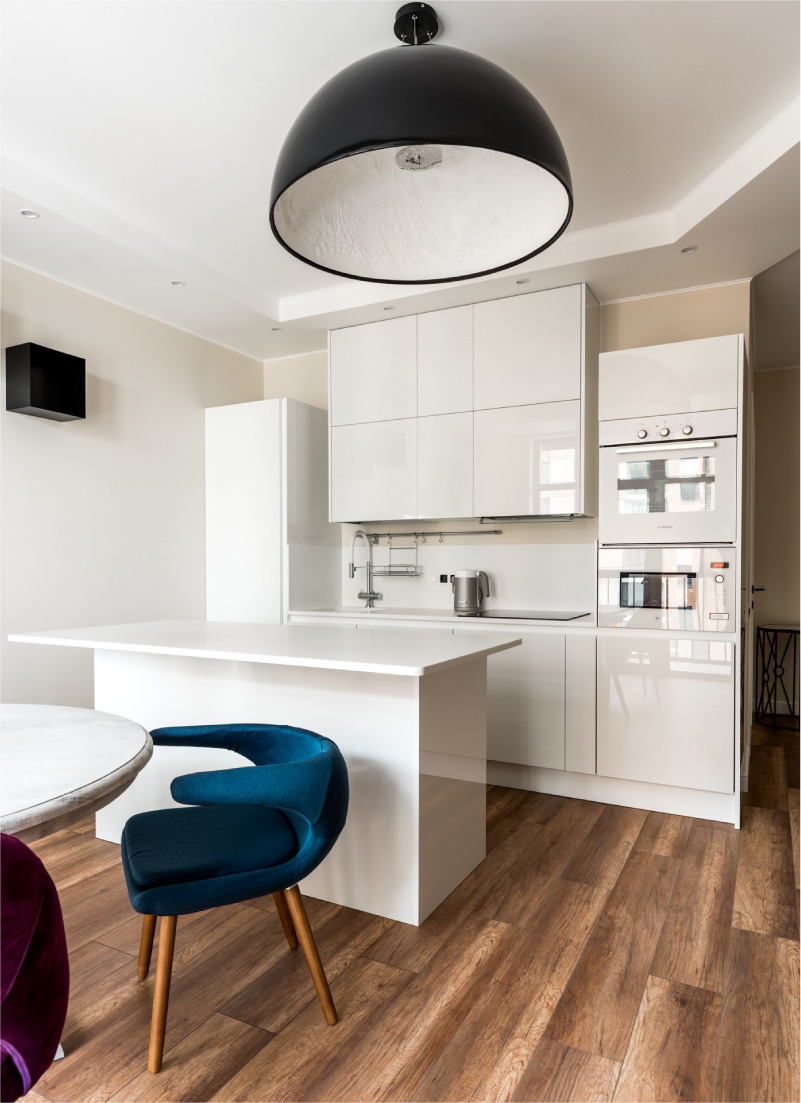
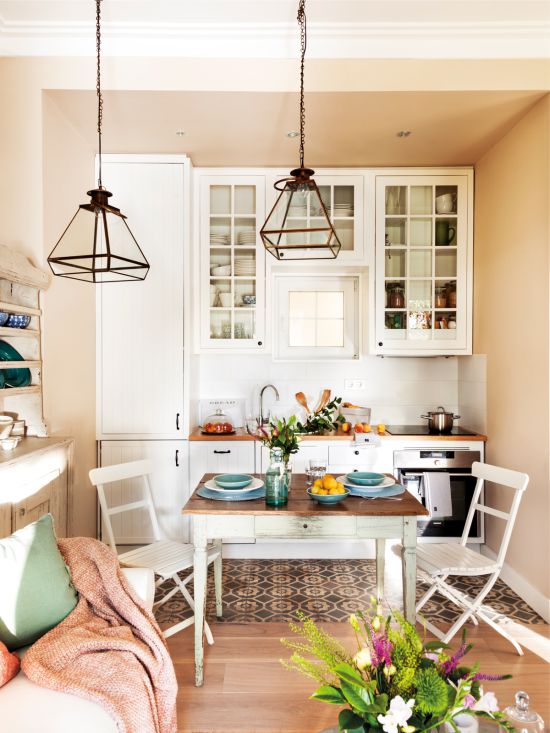
For details, see the material: Plasterboard ceilings in the kitchen - from design to installation
Option 4. Whitewashing the old-fashioned way
The whitewashed ceiling of the kitchen today is not as relevant as it used to be in Soviet times. It was replaced by more modern types of finishes, but so far good old chalk and lime cannot be discounted.
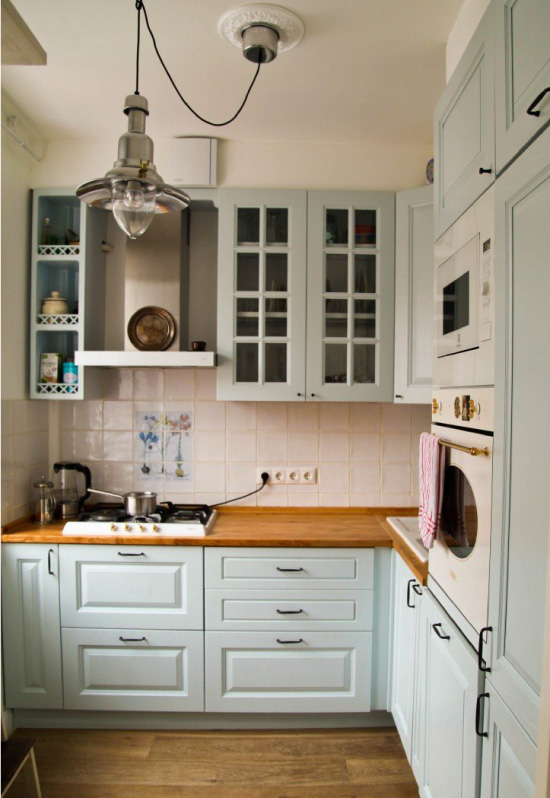
Pros:
- This is the most environmentally friendly, cheap and familiar to many material.
- The whitewashed ceiling due to its porosity provides the best air exchange, and therefore less prone to mold. And even if it does appear, it is easier to notice and eliminate it in time (as opposed to suspended ceilings).
- The whitewashed ceiling looks good, fits perfectly into classic, “rustic”, Scandinavian and eco-friendly interiors. For example, even a cracked bleached ceiling on Provence style kitchen will look more than organic.
- The whitewashed ceiling is compatible with stucco and wooden beams.
- It is very simple and inexpensive to whiten the ceiling with your own hands.
Minuses:
- Whitewashing does not tolerate too much moisture and temperature fluctuations in the kitchen, so it quickly begins to crack and crumble. Also, the whitewashed ceiling will surely crack if the house is new and shrinks (the process lasts 2-3 years).
- It is advisable to update the whitewashing 1-2 times a year, because you cannot wash the whitewashed ceiling in the kitchen (together with greasy stains and soot, the coating itself is washed off).
- Before whitewashing the ceiling should be plastered and leveled to a perfectly smooth state. The repairs themselves, though not complicated, but troublesome - everything in the room needs to be closed with a film, the drying of the layers takes time.
- In contrast to the level constructions, whitewashing of the ceiling does not allow hiding communications and rearranging lamps without stroking the base.
Option 5. Painting
Another traditional option is painting. Painted ceiling looks similar to bleached, but more practical and durable.
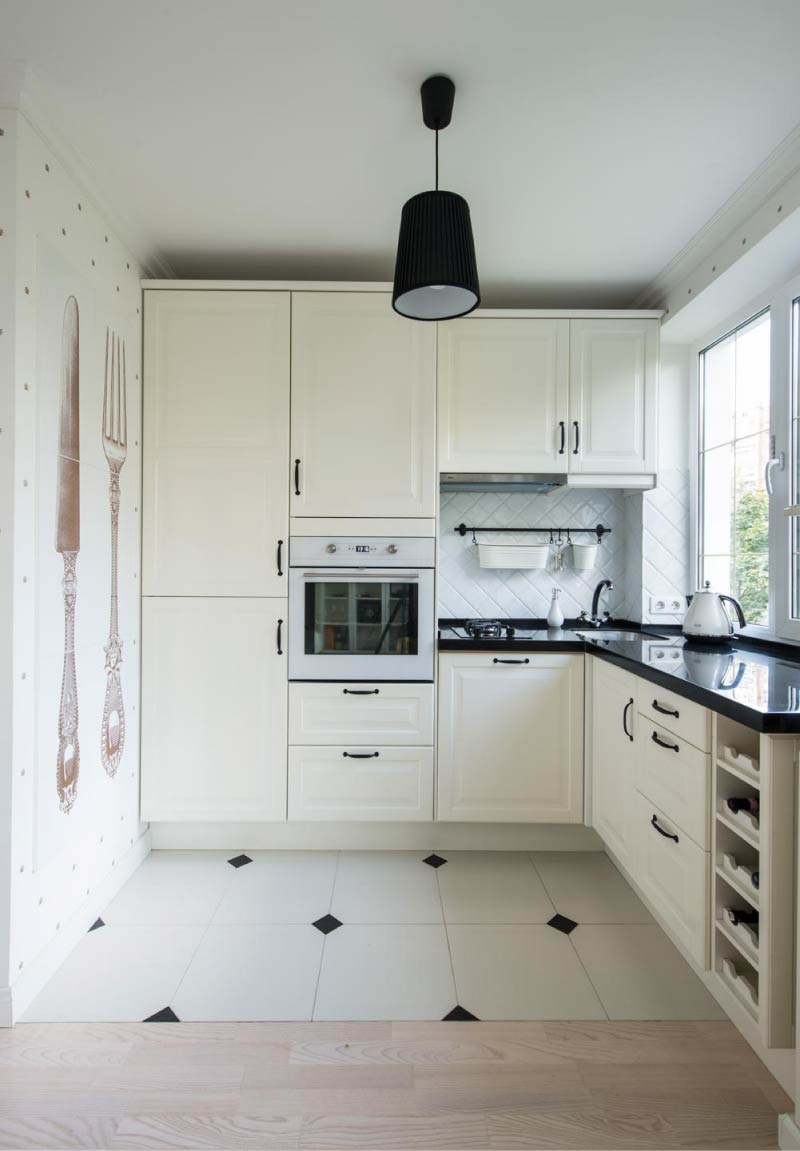
Deep-matt white painted kitchen ceiling
Pros:
- The painted ceiling can be not only white, but also colored or multi-colored. For example, the ceiling can be painted to match the walls, thereby visually increasing their height.
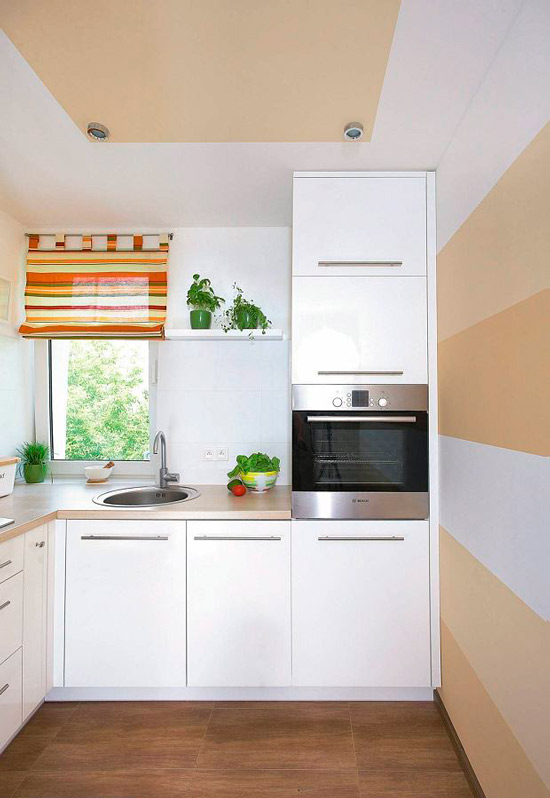
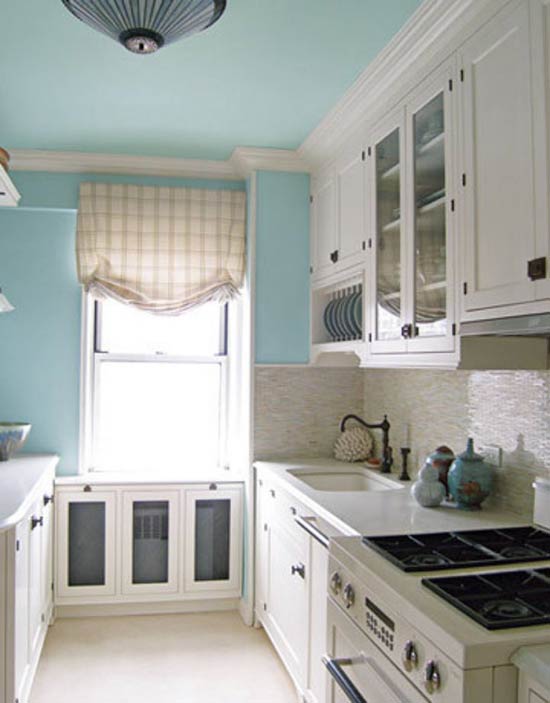
- Painted ceiling can be washed. In addition, it tolerates better moisture than whitened.
- Painting the ceiling with their own hands is not too costly and accessible to beginners.
- Painted ceiling is updated less frequently than whitewashed.
Cons painting the ceiling:
- The paint begins to crack and peel off with time and after leaks.
- Over time, the white ceiling may turn yellow or gray.
- There is no possibility of local repair - if the paint cracks in one place, you will have to completely remove the old finish, re-level the ceiling and then paint again.
- Before painting the ceiling must be plastered and leveled to a perfectly smooth state. The repairs themselves, though not complicated, but troublesome - everything in the room needs to be closed with a film, the drying of the layers will take time.
- In contrast to the level constructions, the painted ceiling does not allow hiding communications and rearranging lamps without stroking the base.
Tips for choosing paint for the ceiling:
- Paint for walls must be waterproof and anti-fungal properties.It is best to choose paints specifically designed for kitchen and bathroom ceilings.
- If you want to decorate the ceiling traditionally, then choose matte and deep-opaque paints.
- With the help of stencils, you can decorate the ceiling with your own hands with pretty patterns. This is a more practical alternative to wallpaper.
Option 6. Wallpapering
Ceiling wallpaper can be painted or printed.
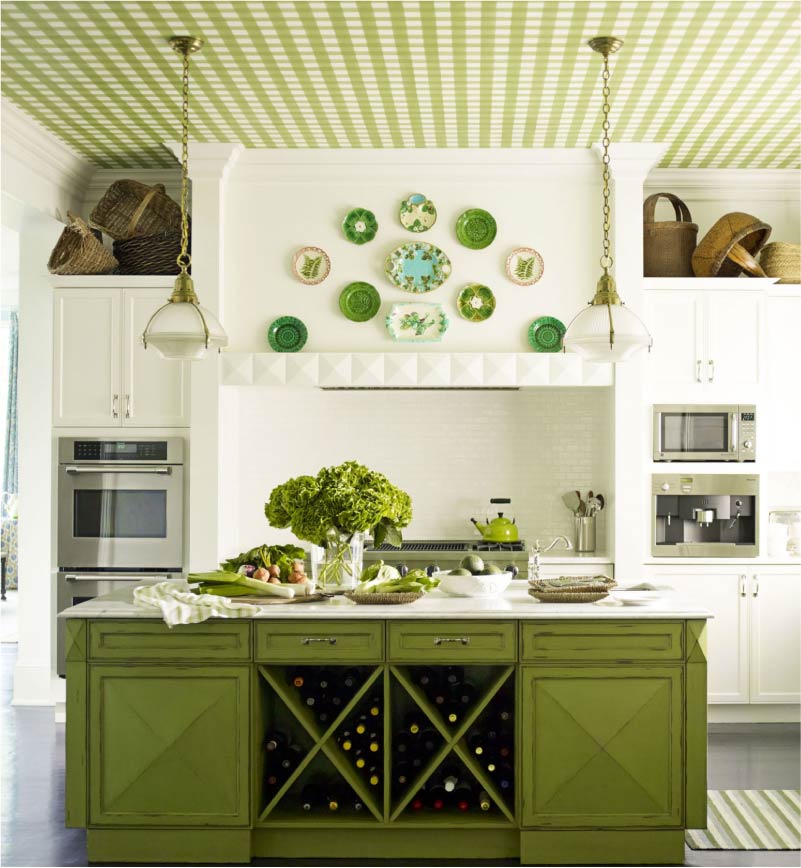
Pros:
- Finishing the ceiling with wallpaper can satisfy any wallet - it can be very economical or, on the contrary, expensive and exclusive.
- The design of the ceiling wallpaper is limitless.
- Ceiling wallpaper can be beautifully combined with wallpaper on the walls.
- Preparing the base for wallpaper is easier than whitewashing or painting. Thick and grooved coatings can hide small irregularities and cracks in the base.
- Ceiling wallpaper can be washed.
- There is the possibility of local repair.
- Ceiling wallpaper for painting can be repainted several times.
Minuses:
- It is quite tiring to cut and glue dense sheets to the ceiling, additionally weighted with glue. By the way, wallpapering requires work of at least 2 people.
- Wallpapers always have seams, which, firstly, can be noticeable, and secondly, they can be deformed and diverge due to the constant effect of heat and fumes from the stove, as well as due to leaks.
Tips for choosing a ceiling wallpaper for the kitchen:
- Wallpaper for kitchen ceilings must be washable and moisture-proof.
- If the ceilings in the kitchen were once struck with mold, then only glass wall panels, non-woven linen for painting, wallpaper made of solid or foamed vinyl are suitable for their finishing. From paper and compact vinyl wallpaper is better to refuse.
Option 7. Plastic ceiling
The plastic ceiling is a cladding with plastic clapboard or PVC ceiling panels.
This type of ceiling decoration is one of the cheapest, but at the same time one of the most practical and durable.
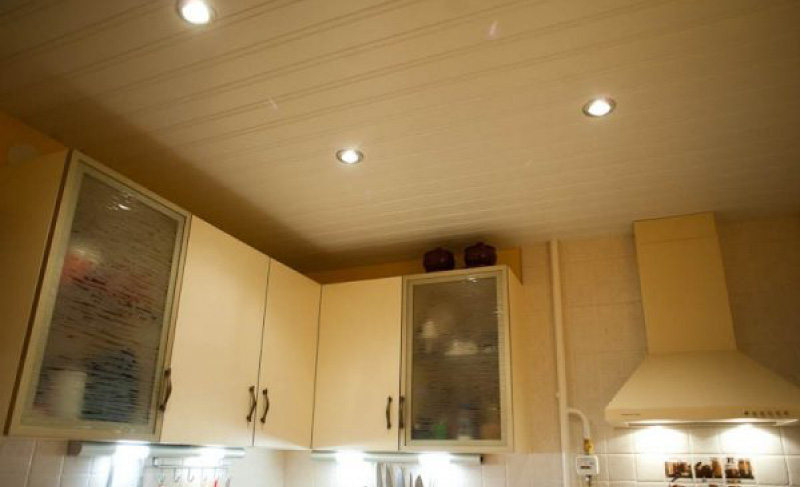
Pros:
- The plastic kitchen ceiling will survive even flooding.
- If any lamellae are damaged, they can always be replaced.
- Plastic ceiling can be washed.
- Plastic lining is available.
- Plastic ceiling panels allow you to hide engineering communications and electrical wires.
- Before installing a suspended ceiling of plastic panels do not need to level the base.
- There are almost no gaps between the slats of the plastic ceiling.
Minuses:
- The minimum loss of height of the walls when installing plastic ceilings is 6-7 cm.
- Cheap PVC panels can release formaldehyde and other toxic fumes.
- Plastic lining is cheap, but it looks very simple. Design options exist a little. Most often on sale you can see the panels in white, beige, cream color, in a shade of chrome, in the decoration under bleached oak or pine, with silver or gold "seams".
- The plastic ceiling under the influence of ultraviolet rays with time turns yellow.
Tips:
- Plastic ceiling is good to use for finishing removable housing or kitchen in the country.
- The plastic ceiling in the kitchen needs to be cleaned quite often, because if a thick layer of grease and soot is fixed, then it will be extremely difficult to clean it.
- Plastic ceiling, if desired, can be painted.
For details, see the material: Plastic panels on the ceiling of the kitchen - profitable and practical
Original ways to design the ceiling
Wooden ceiling in natural color (in the apartment)
The lining of wooden paneling, boards or ceiling panels (or imitation of MDF) can fit into any interior and give it a feeling of comfort and style. However, if the kitchen is small and with a low ceiling, then it is better to use this material in doses. For example, to make the transition from the ceiling to the wall to highlight the dining or, on the contrary, the working area, as shown in the photo below.
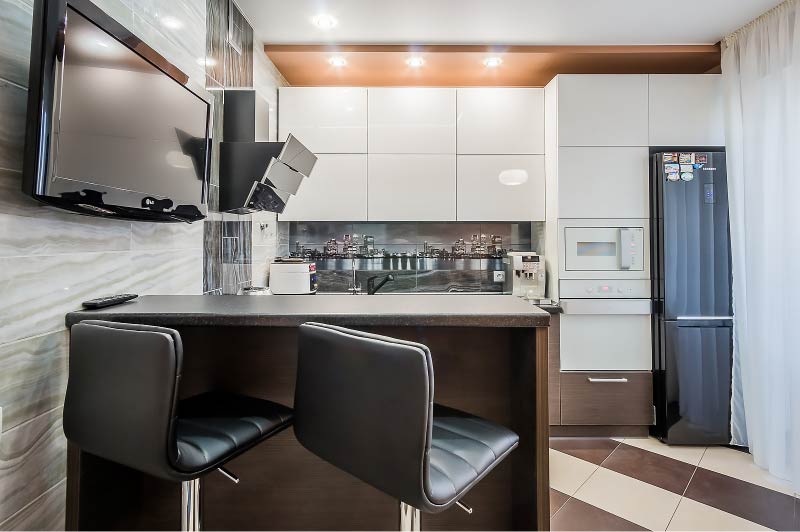
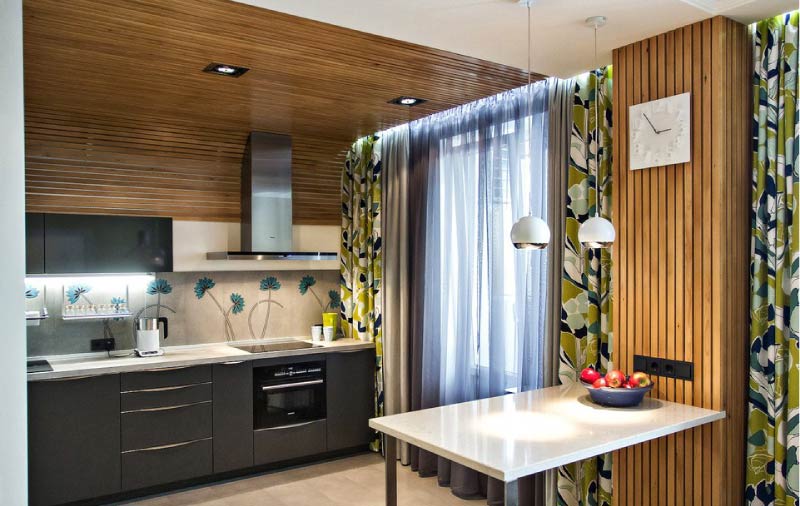
Ceiling beams
AT classic, "Village" or industrial interiors ceiling beams help create the right atmosphere at home with history.The only advice is to use beams of natural wood with a rough texture.
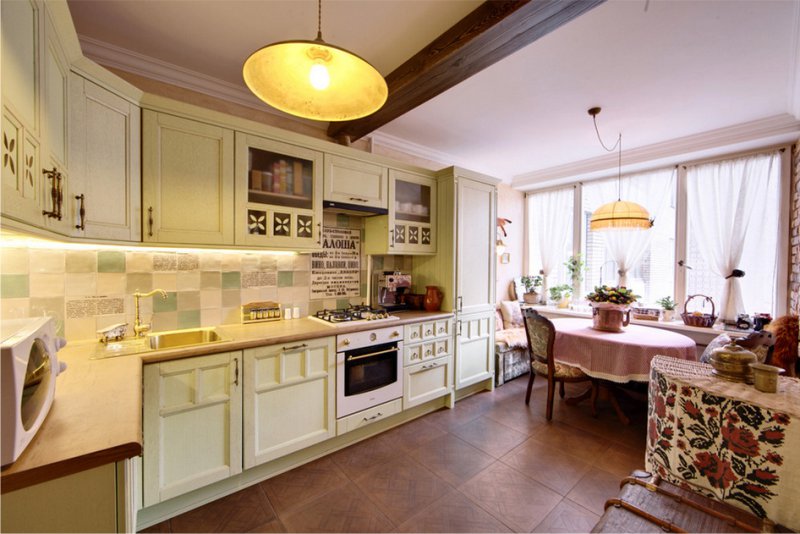
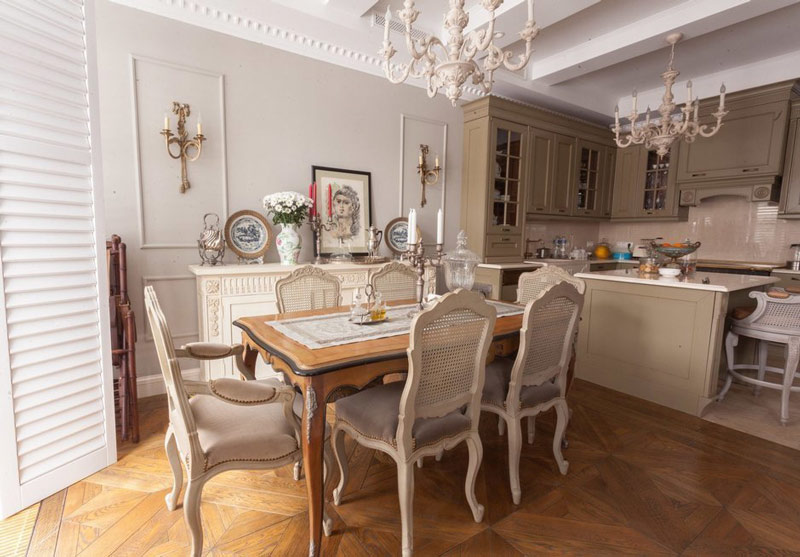
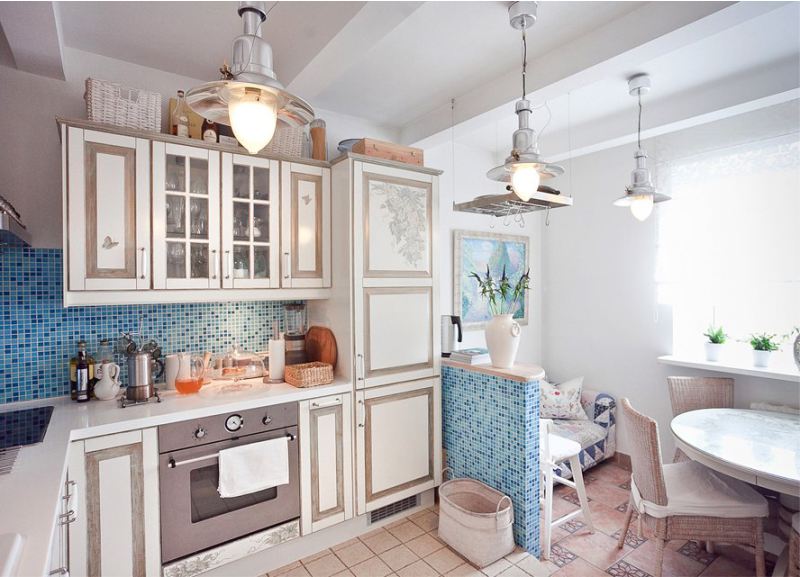
Caisson ceilings
Caisson ceilings - a finish worthy of ceilings kitchens in good stalinkah, country houses and premium class apartments. A prerequisite for the use of caissons: high ceilings (from 2.7 m), a large area and restrained interior design. In the photo below is an example of kitchen decoration with coffered ceiling made of chipboard in the program “The housing problem”.
Ceiling moldings and moldings
If the kitchen is decorated traditionally, and the ceiling is simply whitewashed / painted, then it can be decorated with stucco and / or moldings. They will help to focus on the beautiful chandelier, highlight the dining area and make the interior solemn.
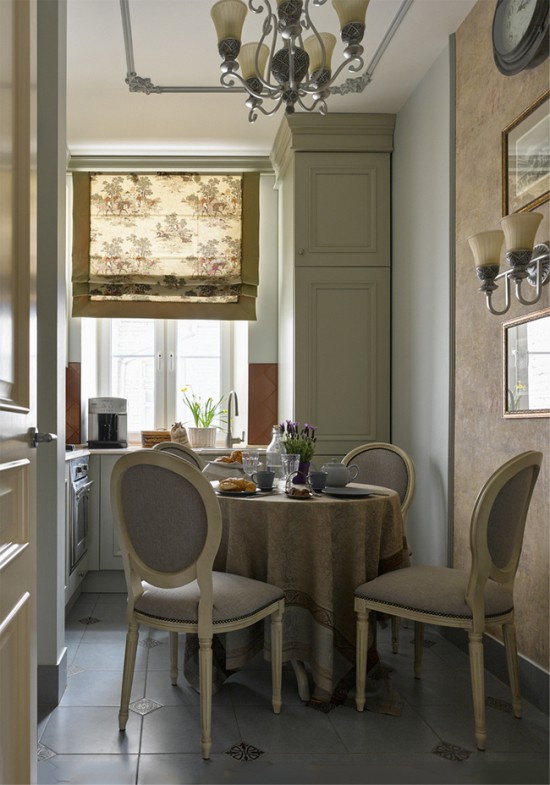
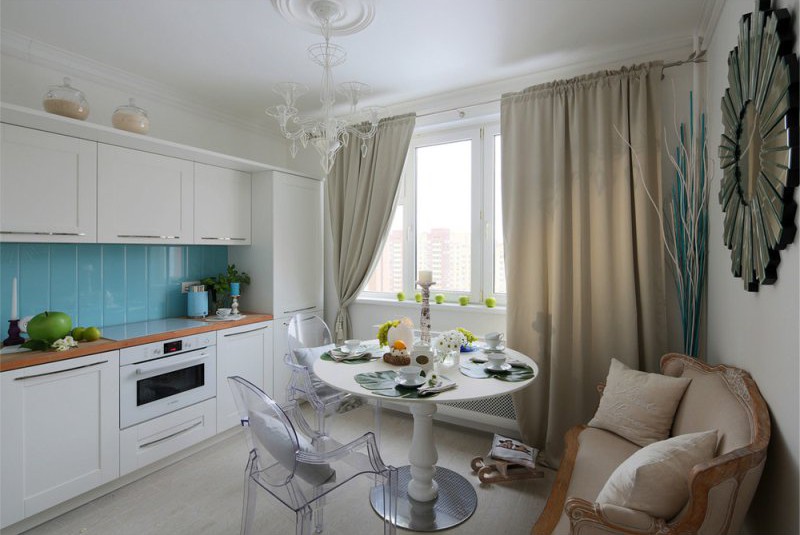
Paint on concrete
If you do not plaster the floor slabs, but simply treat them with a primer and paint, you will get the perfect ceiling loft or industrial as in this photo.
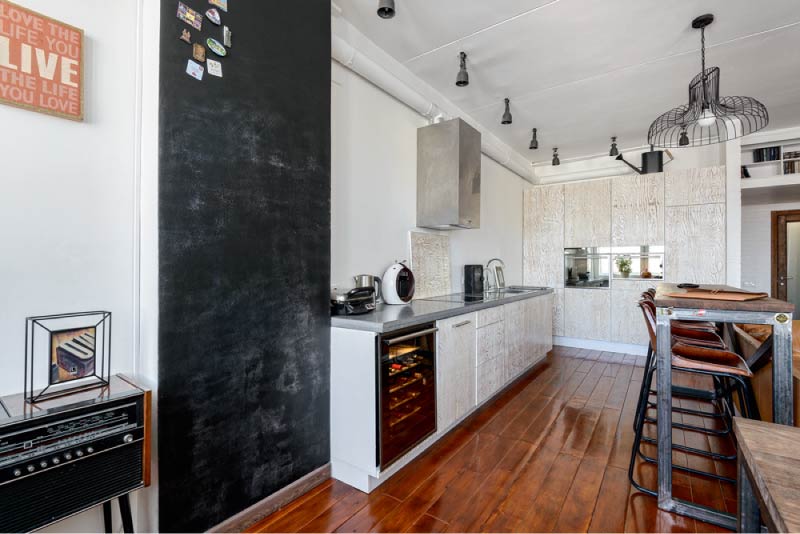
And here is a photo of a kitchen with a concrete ceiling without any finishing.
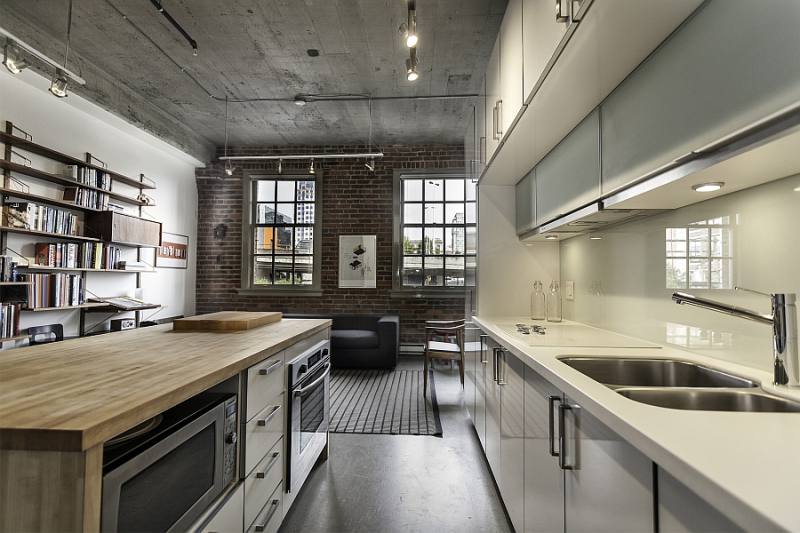
- Rack ceiling in the kitchen - features of choice and installation
- Plastic panels on the ceiling of the kitchen - profitable and practical
- Plasterboard ceilings in the kitchen - from design to installation
- Stretch ceilings in the kitchen - design, care, myths and reality
- How to repair the ceiling in the kitchen with their own hands
- How to wash the stretch ceiling without stains in 5 steps

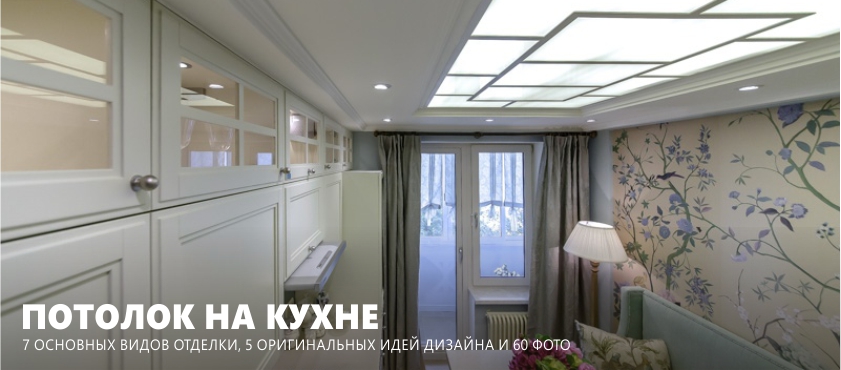
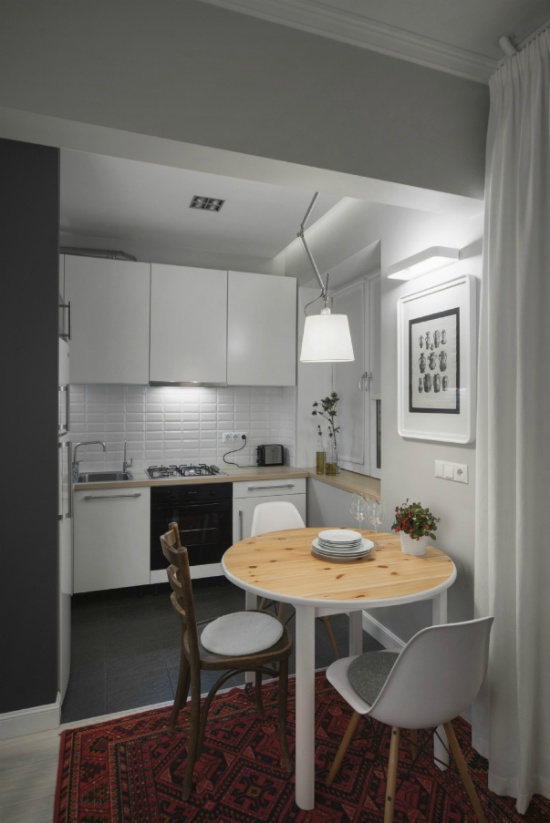
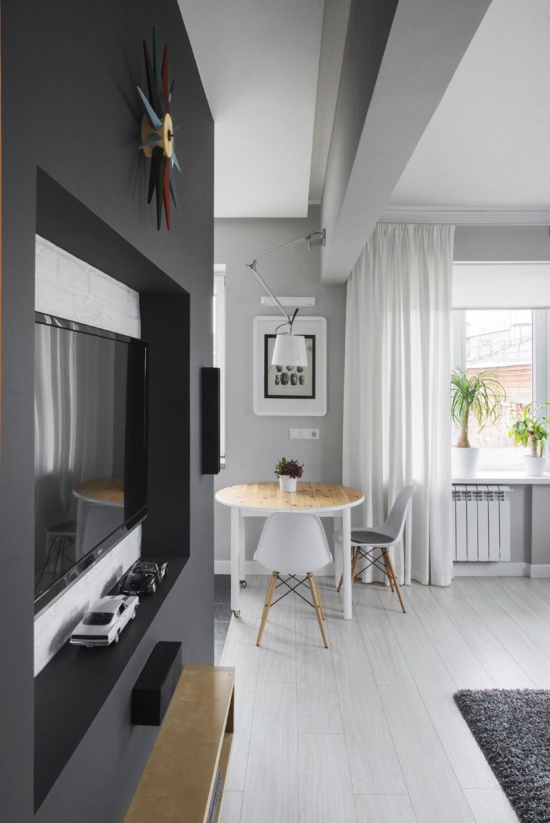

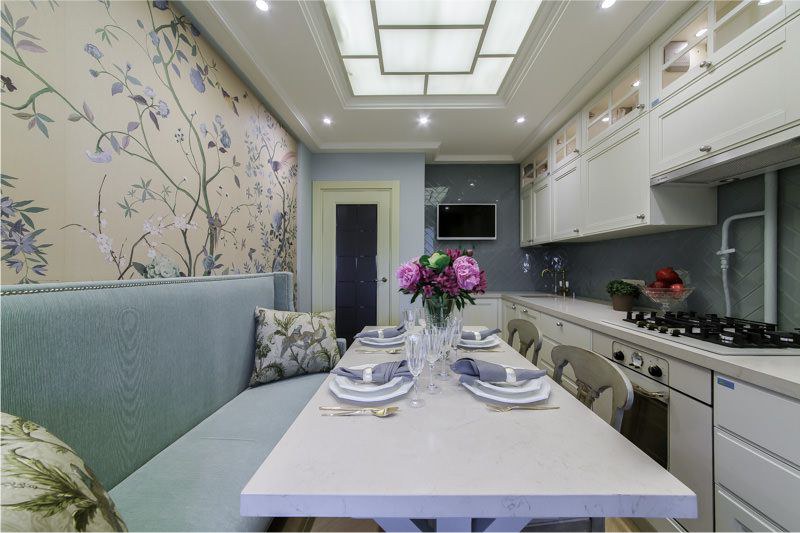
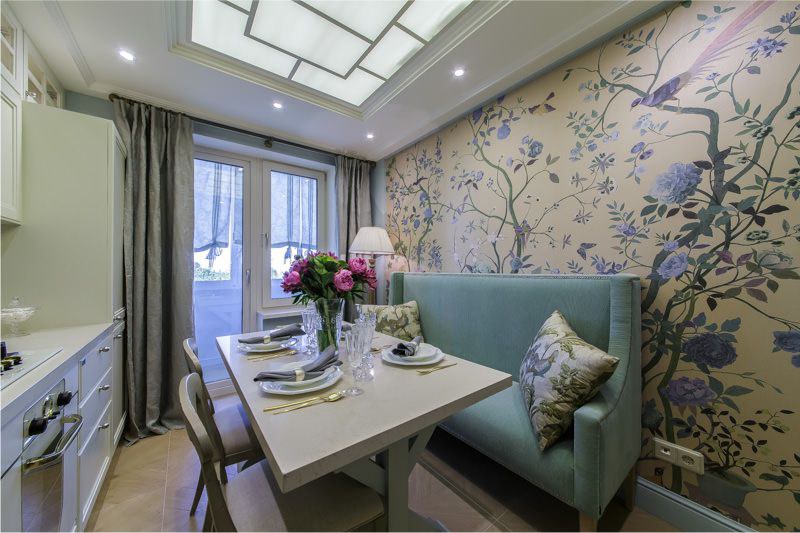
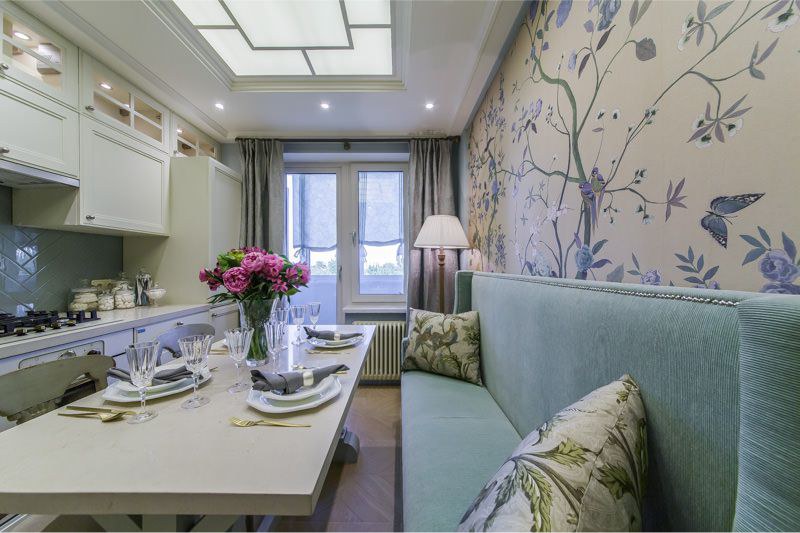
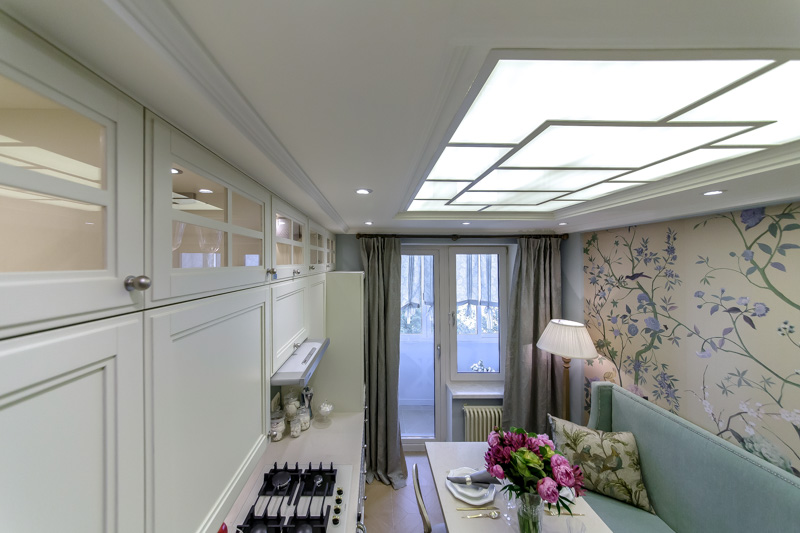
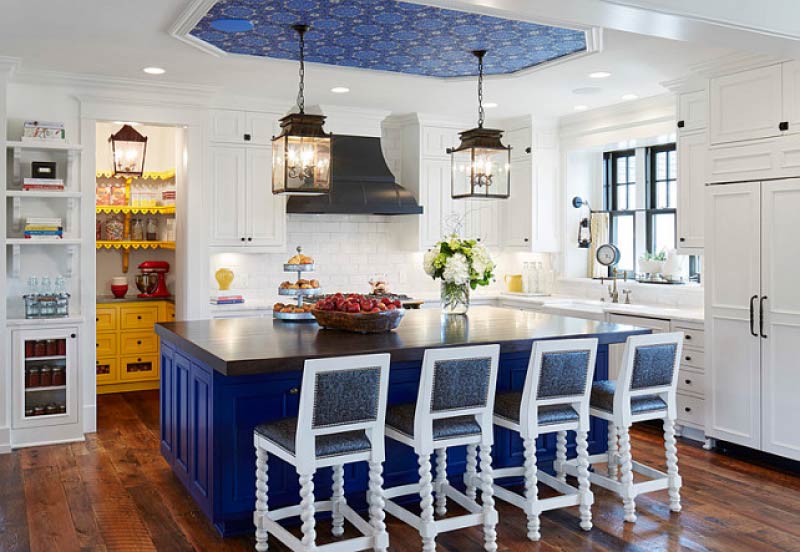
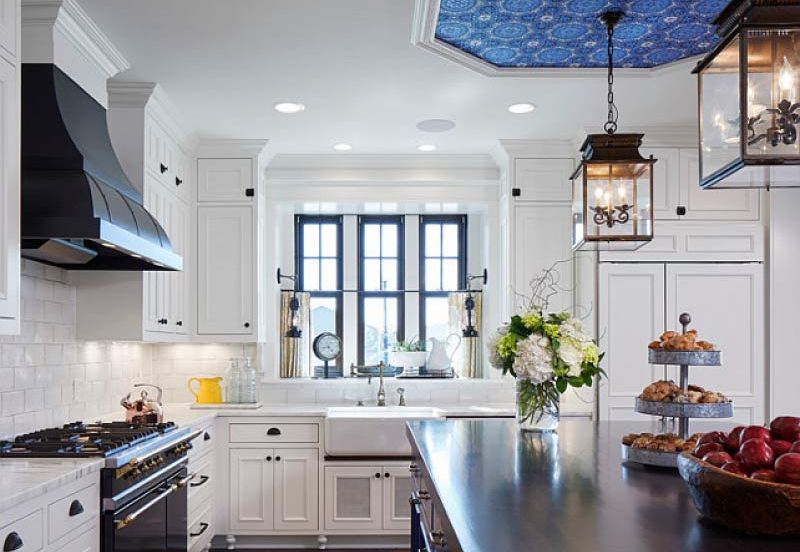
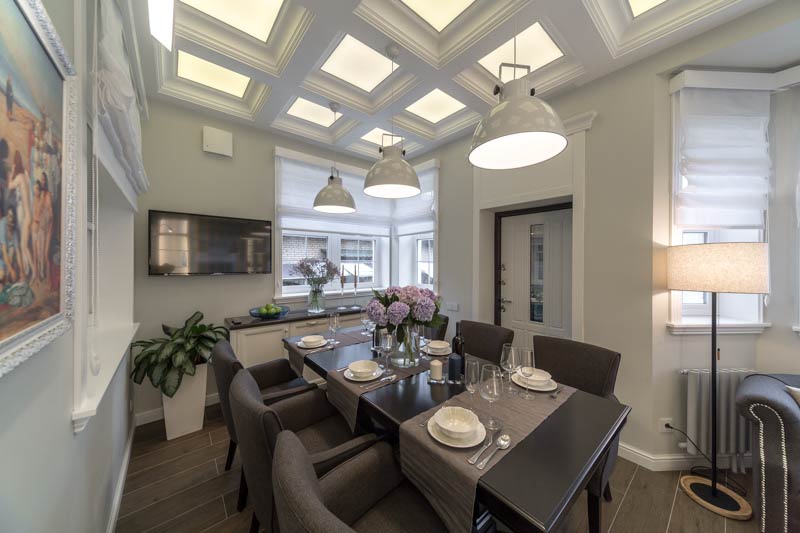
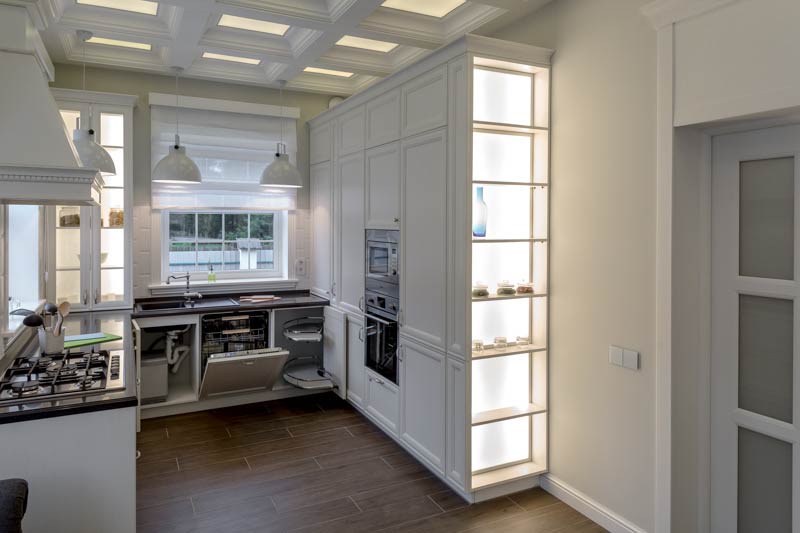
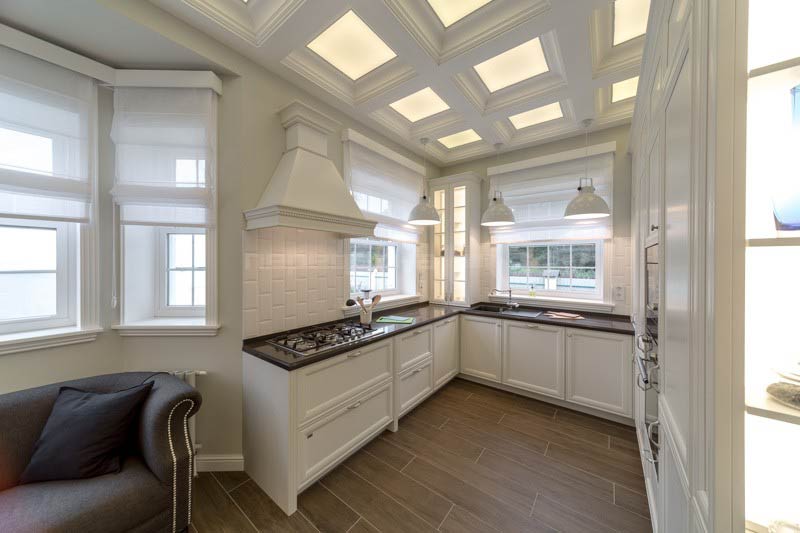

 (Rate the material! Already voted:67 average rating: 4,64 from 5)
(Rate the material! Already voted:67 average rating: 4,64 from 5)
Very informative text!